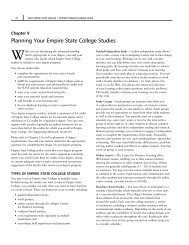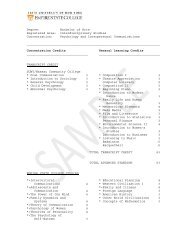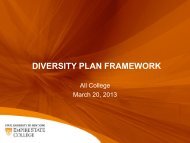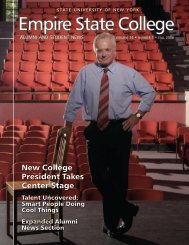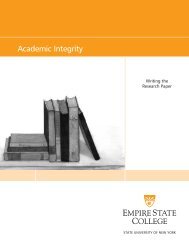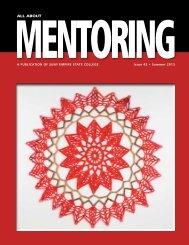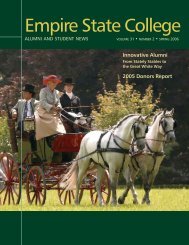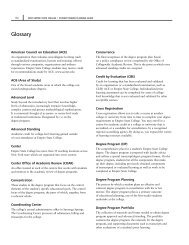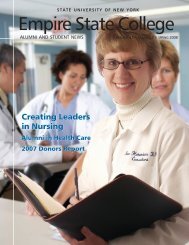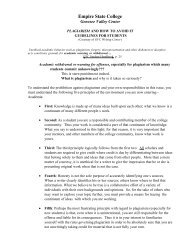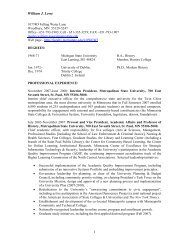Academic Plan 2011-2015 (PDF 524kB) - SUNY Empire State College
Academic Plan 2011-2015 (PDF 524kB) - SUNY Empire State College
Academic Plan 2011-2015 (PDF 524kB) - SUNY Empire State College
You also want an ePaper? Increase the reach of your titles
YUMPU automatically turns print PDFs into web optimized ePapers that Google loves.
46 <strong>SUNY</strong> <strong>Empire</strong> <strong>State</strong> <strong>College</strong>: <strong>Academic</strong> <strong>Plan</strong> <strong>2011</strong> - <strong>2015</strong>the arts allows for a broad investigation of theoretical debates, as well as contemporary scholarship inmedia studies, communications, public history and the arts and related fields. Finally, this theme canhelp to provide a multidisciplinary approach to explore the implications of a changing media landscapeand how this translates into communicating ideas in an increasingly complex society.RationaleWe are living in a period of rapid globalization, in which individual human interactions, markets andcultural values are increasingly mediated by new tools that facilitate communication and the flow ofinformation. Yet, information itself does not constitute either knowledge or wisdom. The variety andubiquity of media prompt us to consider its influence on our lives. As an institution of higher learning,it is, therefore, critical that we take the lead in facilitating a better understanding of how societiesrepresent themselves, with the goal of improving how we communicate ideas across global, temporaland geographical divides. In so doing, this theme also can help enhance the college’s reputationfor research and scholarship, as well as honor its commitment to promoting social justice througharticulating the historical and social circumstances in which power and identity are transmitted andcommunicated to larger audiences.Another critical aspect of the college’s mission is that we should be able to respond to students’needs for a degree that can offer them marketable skills, as well as a strong liberal arts background.As an institution, <strong>Empire</strong> <strong>State</strong> <strong>College</strong> has demonstrated its ongoing commitment to support theeconomic and cultural development of our students and the communities in which they reside throughproviding them with access to affordable and high-quality educational opportunities. The theme ofcommunication, media and the arts fulfills these goals by allowing students to pursue an intellectuallychallenging academic program that provides them with the theoretical skills to understand complexmedia environments, while at the same time helping them to apply these skills to everyday life.In practice, many of the students who come to <strong>Empire</strong> <strong>State</strong> <strong>College</strong> would like to become producersof media, including learning the skills to be journalists, public relations or advertising professionals,broadcasters, digital media specialists, etc. They also may be practicing graphic studio or digitalperforming artists. Development of this theme would allow these students to realize their professionalinterests by offering them course work and learning experiences that provide them with up-to-dateskills that will help them find gainful employment in these fields. This assumes that the college also willcreate more learning opportunities in this area, drawing on the expertise of the faculty, as well as hiringmore faculty in these fields, as part of an overall commitment to supporting learners as active partnersin their education within a collaborative mentoring environment.Finally, the demand overall for degrees in cultural studies – the arts, as well as fields like history andinterdisciplinary studies – continues to grow. For example, at the undergraduate level, the amount ofbachelor’s degrees awarded in Cultural Studies in 2009 - 2010 was 7.5 percent of the total degreesawarded; 5.4 percent of the degrees were in The Arts; Historical Studies accounted for 3.9 percent; andInterdisciplinary Studies accounted for 6.0 percent. At the graduate level, the Master of Arts in LiberalStudies accounted for 7 percent of the total degrees. These numbers suggest that there is a strongamount of interest in pursuing degrees that potentially could focus on this theme, especially when it isunderstood as being part of a cross-disciplinary pursuit that, combined with some of the other themesoutlined in the academic plan, provides an opportunity to realize fully the academic and professionalinterests of our students.




